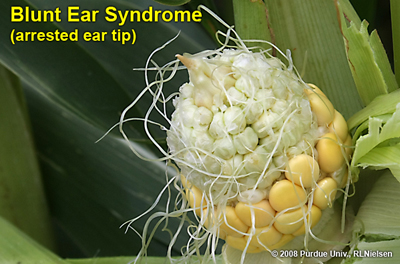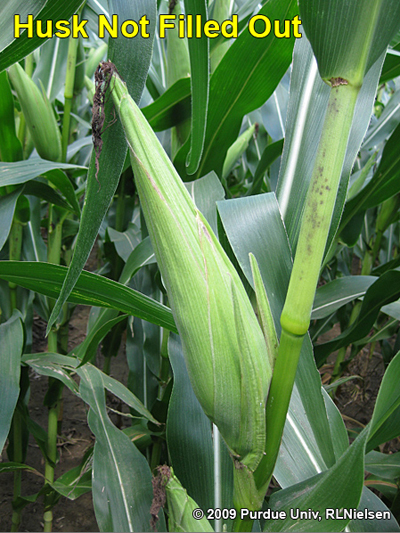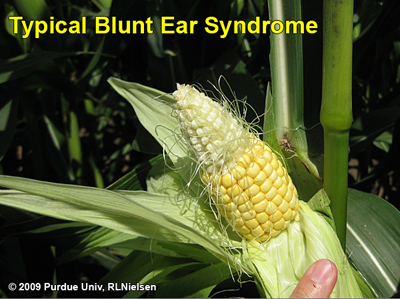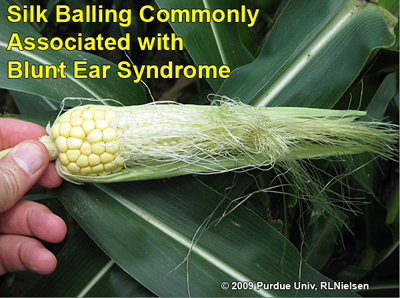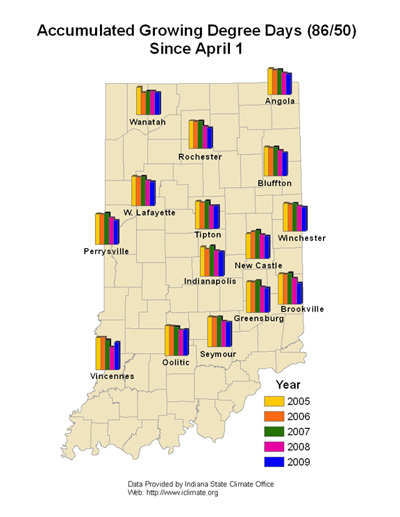Pest & Crop Newsletter, Entomology Extension, Purdue University
Western Bean Cutworm Update - (Christian Krupke and John Obermeyer)
- We need help identifying the Indiana range of this pest.
- With earworm populations so low this year, mis-identification risk is lessened.
- Small “worms” around wound sites are likely sap beetle larvae – not economically important.
Pest managers continue to monitor for the presence and density of western bean cutworm (WBC) larvae/ear damage. So far we have gotten reports of this pest’s damage in Lake, Newton, Jasper, St. Joseph, Starke, Pulaski, and Blackford Counties. Please let us know if you are finding larvae and ear damage elsewhere. Certainly the most interesting find was from Troy Millspaugh, just south of Hartford City. Though the density of larvae and damage was low, this is the farthest east and south reported for this pest in the state.
Unlike some pests, where populations develop in synchrony, WBC has a prolonged egg-laying period that is spread over several weeks. This means there is often a wide range of sizes of caterpillars in the same field at once. This explains how within the same field some damaged ears are vacated, larvae has dropped to the ground (see accompanying video), whereas others have small larvae feeding at the ear tip.
This has been a great opportunity to be able to distinguish WBC larvae and damage from the usually common corn earworm. This year, corn earworm’s moth flight and subsequent ear feeding have been extremely low. Corn earworm larvae are similar in appearance and damage to WBC, especially when the worms are small. This has lead to false reports of WBC damage in the past. With your observations from field visits, we can establish the WBC’s range (Ph: 765-494-8761).
Some pest managers looking for ear damage in fields have been seeing some very small, whitish worms. Often, these “worms” (actually grubs) are found in or around a plant wound site, which may or may not have been insect-induced. It is likely that these individuals are finding one of several sap beetle larvae, the most common being the familiar picnic beetle. These beetles, and their larvae, are commonly found in and around damaged and decomposing tissue. They are secondary invaders and will feed on decomposing, fermenting plant material and the sugars produced during this process (this is why they are attracted to beer, wine and other fermentation products). The beetles lay eggs in this rotting material (e.g., a damaged ear tip) so that the larvae have a food source to take them through their development. They are not considered pests, but you should be aware of what you are looking at.
Click on the above link to watch a video on where western bean cutworm larvae go after they're done feeding on the ear.
Picnic beetle, the most recognized sap beetle
Sap beetle larvae, note the two projections at the tip of the abdomen
Dusky sap beetles in leaf axil
![]()
Click here to view the Black Light Trap Catch Report
Blunt Ear Syndrome....Again - (Bob Nielsen)
Like the swallows that return to San Juan Capistrano every year, reports of Blunt Ear Syndrome (BES) or Beer Can Ear Syndrome (BCES) seem to surface every year sometime during mid to late August. This form of arrested ear development was first described in Colorado in 1989, was very prevalent across much of the Midwest in 1992, and has occurred in varying frequencies every year since.
The cause of this problem has never been conclusively determined. Some believe the occurrence of BES is associated with high soil pH or low-lying ponded areas of fields or herbicide injury. However, I have walked numerous fields with BES over the years that were not associated with any of these proposed causal factors.
NEPAC Weather 2009 - Example of timing of leaf stage and air temperature relative to the occurrence of BES in a field in NE Indiana, 2009
I personally lean toward the effects of a cold temperature shock during ear size determination that either directly injures ear shoot tissue or alters the hormonal balance within the developing ear shoot. Evidence of the role that cold temperature shock could play in this phenomenon was documented by researchers in Europe (Bechoux et al., 2000; Lejeune & Bernier, 1996; Lejeune et al., 1998). In most of the BES cases where I have been able to document planting date and had access to nearby temperature data, there is usually a period during ear size determination (V6 ~ V12) where daily minimum air temperatures dropped from lows near 70F to lows in the mid-50’s or lower for a short period of time before recovering to earlier warmer daily minimums.
The accompanying images illustrate the classical symptoms associated with BES. The first image set came from a BES field in 2008 where the affected ears were located primarily in the first 10 or so rows along the edge of a field and scattered throughout the remainder of the field; primarily in areas relatively lower in elevation than adjacent areas. I have often found BES in lower areas of the field (which would support my cold temperature theory), but I admit that that sometimes BES is restricted primarily to higher elevations within a field. The second image set came from a BES field in 2009 where the affected ears were found throughout the field at frequencies as high as 80 to 90 percent on two hybrids.
Figures 1-4. Images of BE from field in 2008 where problem was primarily locate in the first 10 rows or so aong the edge of a field.
The number of kernel rows of affected ears is usually fairly normal at the base of the cob, but then the cob simply truncates abruptly. Silk balling commonly occurs as a result of the silks from the unusually short cob failing to elongate successfully through the normal length, but tight husk leaves. Consequently, there is often some degree of barren cob associated with BES. A rudimentary ear tip is usually visible at the end of the truncated cob that suggests that the stress that triggers the BES occurs during ear size determination (Nielsen, 2007a).
Plants with severe BES symptoms may turn purplish-red later in the grain filling period as anthocyanin pigments develop in response to the accumulation of photosynthetic sugars in the leaves and stalk because of the paucity of kernels on the cob. The purpling response is similar to that which often develops early in the growing season (Nielsen, 2008).
If you come across fields that exhibit these BES symptoms, please consider submitting some background information on those fields to an on-line database that may eventually help identify common threads among affected fields. The information I would like to receive is summarized below and the on-line database form is located at <http://www.zoomerang.com/Survey/?p=WEB22864Y5G52Y>. If you would rather send me the information by email, that would be fine also.
• State (location) of the affected field.
• Planting date of the affected field.
• Seed company (e.g., Bob’s Pretty Good Hybrids).
• Hybrid number (e.g., BN2821).
• Approximate percent of field that is affected with BES.
• Approximate percent of ears affected with BES within the affected area.
• Average length (inches) of affected cobs.
• Average number of kernels per row on affected ears.
• Average number of kernel rows on affected ears.
• Soil pH levels of affected field.
• Other soil test information from affected field.
• General location of affected area within field (throughout, field edges, high ground, low ground, etc.).
• Relative soil drainage of affected area (well-drained, poorly drained, etc).
• Herbicides applied this year (product, rates, application times).
• Fungicides applied this year (including seed treatments)
Related References
Bechoux, N., G. Bernier, and P. Lejeune. 2000. Environmental effects on the early stages of tassel morphogenesis in maize (Zea mays L.). Plant, Cell & Environment. 23(1):91-98.
Lejeune, P. and G. Bernier. 1996. Effect of environment on the early steps of ear initiation in maize (Zea mays L.). Plant, Cell & Environment. 19:217-224.
Lejeune, Pierre, Prinsen, Els, Onckelen, Henry Van, and Bernier, Georges. 1998. Hormonal control of ear abortion in a stress-sensitive maize (Zea mays) inbred. Functional Plant Biol. 25[4], 481-488.
Nielsen, R.L. (Bob). 2001. ‘Beer Can’ Ear Syndrome - 2001. Corny News Network, Purdue Univ. [Online] <http://www.kingcorn.org/news/articles.01/Beer_Cans-0907.html>. [URL accessed 8/25/09].
Nielsen, R.L. (Bob). 2003. Blunt Ear Syndrome in Corn. Corny News Network, Purdue Univ. [Online] <http://www.kingcorn.org/news/articles.03/BeerCanEars-0812.html>. [URL accessed 8/25/09].
Nielsen, R.L. (Bob). 2007a. Ear Size Determination in Corn. Corny News Network, Purdue Univ. [Online] <http://www.kingcorn.org/news/timeless/EarSize.html>. [URL accessed 8/25/09].
Nielsen, R.L. (Bob). 2007b. Symptomology of Arrested Ear Development in Corn. Corny News Network, Purdue Univ. [Online] <http://www.kingcorn.org/news/articles.07/ArrestedEars-0904.html>. [URL accessed 8/25/09].
Nielsen, R.L. (Bob). 2008. Prevalent Purple Plants Possibly Puzzle Producers. Corny News Network, Purdue Univ. [Online] <http://www.kingcorn.org/news/timeless/PurpleCorn.html>. [URL accessed 8/25/09].
Pearson, Calvin. 1998. Evaluation of Golden Harvest Corn Hybrids for Blunt Ear Syndrome. Western Colorado Research Center 1998 Annual Report. Colorado State Univ., Fruita, CO. [On-Line]. Available at <http://www.colostate.edu/Depts/AES/Pubs/pdf/bluntear.pdf>. [URL accessed 8/25/09].
Pearson, Calvin and William E. Brown. 1999. Effect of Methyl Bromide and Golden Harvest and Pioneer Corn Hybrids under Two Irrigation Managements on Blunt Ear Syndrome at Fruita, Colorado 1999. Western Colorado Research Center 1999 Annual Report. Colorado State Univ., Fruita, CO. [On-Line]. Available at <http://www.colostate.edu/Depts/AES/Pubs/pdf/BES99.htm>. [URL accessed 8/25/09].
Pearson, Calvin. 2000. How Blunt Ear Syndrome of Corn is Affected by Hybrid and Irrigation at Fruita, Colorado 2000. Western Colorado Research Center 2000 Annual Report. Colorado State Univ., Fruita, CO. [On-Line]. Available at <http://www.colostate.edu/Depts/AES/Pubs/pdf/Pearson_BluntEarSyndrome.html>. [URL accessed 8/25/09].








